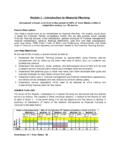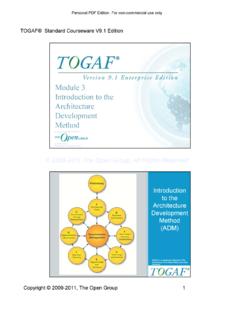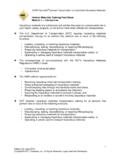Transcription of Antimicrobial Use and Resistance (AUR) Option
1 Antimicrobial Use and Resistance module AUR. Antimicrobial Use and Resistance (AUR) module Table of Contents introduction 1. 1. Antimicrobial Use (AU) Option 2. introduction 2. Requirements 3. Data Analyses 7. Appendix A. Table of Instructions: Antimicrobial Use 11. Appendix B. List of Antimicrobials 12. Appendix C. Example Calculations of Antimicrobial Days 16. Appendix D. Antimicrobial groupings for SAAR calculations 20. 2. Antimicrobial Resistance (AR) Option 22. introduction 22. Requirements 23. Data Analyses 29. Appendix E. List of Microorganisms for Antimicrobial Resistance 35. Appendix F. Technical and Isolate Based Report Variables 41. Appendix G. Denominator Data Variables 43. introduction This module contains two options, one focused on Antimicrobial use and the second on Antimicrobial Resistance . To participate in either Option , facility personnel responsible for reporting Antimicrobial use (AU) or Resistance (AR) data to the National Healthcare Safety Network (NHSN) must coordinate with their laboratory and/or pharmacy information software providers to configure their system to enable the generation of standard formatted file(s) to be imported into NHSN.
2 The format provided for data submission follows the Health Level (HL7). Clinical Document Architecture (CDA).7 Manual data entry is not available for the AUR. module . Facilities can participate in one (AU or AR) or both (AU and AR) options at any given time. Purpose: The NHSN AUR module provides a mechanism for facilities to report and analyze Antimicrobial use and/or Resistance as part of local or regional efforts to reduce Antimicrobial resistant infections through Antimicrobial stewardship efforts or interruption of transmission of resistant pathogens at their January 2018 14-1. Antimicrobial Use and Resistance module AUR. 1. Antimicrobial Use (AU) Option introduction : Rates of Resistance to Antimicrobial agents continue to increase at hospitals in the United One of the four CDC core initiatives to combat the spread of Antimicrobial Resistance is improving the use of Previous studies have shown that feedback of reliable reports of rates of Antimicrobial use and Resistance to clinicians can improve the appropriateness of Antimicrobial Objectives: The primary objective of the Antimicrobial Use (AU) Option is to facilitate risk- adjusted inter- and intra-facility benchmarking of Antimicrobial usage.
3 A secondary objective is to evaluate trends of Antimicrobial usage over time at the facility and national levels. Methodology: The primary Antimicrobial usage metric reported to this module is Antimicrobial days per 1,000 days present. An Antimicrobial day (also known as day of therapy) is defined by any amount of a specific Antimicrobial agent administered in a calendar day to a particular patient as documented in the electronic medication administration record (eMAR) and/or bar coding medication record (BCMA) (refer to Numerator Data section starting on page 14-3); all Antimicrobial days for a specific agent administered across a population are summed in Days present are defined as the aggregate number of patients housed in a patient care location or facility anytime throughout a day during a calendar month (refer to Denominator Data section starting on page 14-6). For each facility, the numerator ( Antimicrobial days) is aggregated by month for each patient care location and overall for inpatient areas facility-wide (specifically, facility-wide inpatient or FacWideIN).
4 Similarly, the denominator (days present) is calculated for the corresponding patient care-location-month or facility-wide inpatient-month. A secondary Antimicrobial usage metric for facility-wide inpatient also reported to this module is Antimicrobial days per 100 admissions. The numerator and denominators are further defined below and must adhere to the data format prescribed by the HL7 CDA Implementation Guide developed by the CDC and Manual data entry is not available for the NHSN AU Option . Settings: All inpatient facilities (for example, general acute care hospitals, critical access hospitals, children's hospitals, oncology hospitals, long term acute care hospitals, and inpatient rehabilitation facilities) enrolled in NHSN and using the Patient Safety Component can participate in the AU Option . Facilities must have the ability to collect the numerator and denominator data electronically and upload those data into NHSN using the required CDA.
5 Specifications. NHSN does not currently support the submission of data into the AU Option from long term care facilities (specifically, skilled nursing facilities, nursing homes) or outpatient dialysis facilities. NHSN strongly encourages the submission of data from all NHSN-defined inpatient locations, facility-wide inpatient (FacWideIN), and select outpatient acute care settings (specifically, outpatient emergency department, pediatric emergency department, and 24-hour observation area) from which the numerator and denominator data can be accurately captured. A. comprehensive submission will enable a facility to optimize inter- and/or intra-facility comparisons among specific wards, combined wards, and facility-wide data. January 2018 14-2. Antimicrobial Use and Resistance module AUR. Within NHSN, a CDC-defined designation is given to each patient care area/location where patients have similar disease conditions or are receiving care for similar medical or surgical specialties.
6 Each facility location is mapped to one CDC Location within the NHSN facility. The specific CDC Location code is determined by the type of patients cared for in that area according to the NHSN location mapping algorithm for acuity level and service type. The patient care areas include adult, pediatric, and neonatal units as defined by NHSN Codes. See the NHSN. Locations chapter for more information regarding location mapping. Note that the same patient care locations should be used throughout NHSN for both AUR and HAI reporting. Facilities should not map separate locations only for AUR reporting. Requirements: An acceptable minimal month of data includes: 1. The facility must indicate the specific locations from which they plan to submit Antimicrobial use data on the Patient Safety Monthly Reporting Plan (CDC ). When reporting AU Option data from inpatient and outpatient locations, list FacWideIN, each individual inpatient location, and each individual outpatient location as separate rows in the plan.
7 2. The CDA files contain all data fields outlined in the Table of Instructions (Appendix A). for each location of data submitted. 3. Data are uploaded via CDA files for all locations indicated on the Monthly Reporting Plan. NHSN recommends that data be entered into NHSN for a given calendar month by the end of the subsequent calendar month. Numerator Data ( Antimicrobial Days): Antimicrobial Days (Days of Therapy): Defined as the aggregate sum of days for which any amount of a specific Antimicrobial agent was administered to individual patients as documented in the eMAR and/or Appendix B provides the full list of Antimicrobial agents collected in the NHSN AU Option . Aggregate Antimicrobial days are reported monthly for inpatient locations, facility-wide inpatient (FacWideIN), and three select outpatient acute care settings (specifically, outpatient emergency department, pediatric emergency department, and 24-hour observation area) for select Antimicrobial agents and stratified by route of administration (specifically, intravenous, intramuscular, digestive, and respiratory).
8 Refer to Table 1 and Table 2 for definitions of drug-specific Antimicrobial days and stratification based on route of administration. For example, a patient to whom 1 gram Vancomycin is administered intravenously twice daily for three days will be attributed three Vancomycin Days (total) and three Vancomycin Days (IV) when stratified by intravenous route of administration. Please note that antimicrobials that have an extended half-life such as Dalbavancin and Oritavancin are only counted as an Antimicrobial day on the day of administration. Similarly, in the setting of renal impairment, antimicrobials such as Vancomycin are only counted as an Antimicrobial day on the day of administration. Table 3 summarizes the January 2018 14-3. Antimicrobial Use and Resistance module AUR. data elements for numerator calculation. Appendix C provides additional examples for the calculation of Antimicrobial days.
9 Please note that zero should be reported when no aggregate usage occurred during a given reporting period for a specific Antimicrobial agent/route (for example, Zanamivir via the respiratory route) at a facility in which the agent/route is used and that agent/route can be accurately captured in the eMAR or BCMA system. Further, NA (Not Applicable) should be reported when data are not available for a specific Antimicrobial agent/route at a facility (specifically, the agent can't be electronically captured at that facility). A value (specifically, a specific number, zero , or NA ) must be reported for every Antimicrobial agent and route of administration listed in Appendix B. Table 1. Classification and Definitions of Routes of Administration for Antimicrobial Days Classification: Definitionb Route of Administrationa Intravenous (IV) An intravascular route that begins with a vein.
10 Intramuscular (IM) A route that begins within a muscle. Digestive Tract A route that begins anywhere in the digestive tract extending from the mouth through Respiratory Tract A route that begins within the respiratory tract, including the oropharynx and nasopharynx. a Other routes of administration are excluded from the AU Option reporting (for example, antibiotic locks, intraperitoneal, intraventricular, irrigation, topical) and should not be included in either the total Antimicrobial days nor the sub-stratification of the routes of administration. b Definitions were drawn from SNOMED qualifier value hierarchy. Refer to the CDA Antimicrobial Use (AU) Toolkit for specific codes corresponding to each route of administration. c For example, rectal administration of Vancomycin. Table 2. Example Stratification of Antimicrobial Days by Route of Administration Month/ Drug-specific Antimicrobial Days Year- Antimicrobial Total a IV IM Digestiveb Respiratory Location Agent Month/ Tobramycin Tobramycin Tobramycin Tobramycin Tobramycin Year Tobramycin Days Days Days Days Days Location (Total) (IV) (IM) (Digestive) (Respiratory).















